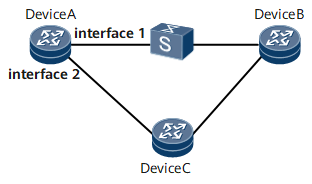BFD for OSPFv3
Definition
Bidirectional Forwarding Detection (BFD) is a mechanism to detect communication faults between forwarding engines.
To be specific, BFD detects the connectivity of a data protocol along a path between two systems. The path can be a physical link, a logical link, or a tunnel.
In BFD for OSPFv3, a BFD session is associated with OSPFv3. The BFD session quickly detects a link fault and then notifies OSPFv3 of the fault, which speeds up OSPFv3's response to network topology changes.
Purpose
A link fault or a topology change causes routers to recalculate routes. Routing protocol convergence must be as quick as possible to improve network availability. Link faults are inevitable, and therefore a solution must be provided to quickly detect faults and notify routing protocols.
BFD for Open Shortest Path First version 3 (OSPFv3) associates BFD sessions with OSPFv3. After BFD for OSPFv3 is configured, BFD quickly detects link faults and notifies OSPFv3 of the faults. BFD for OSPFv3 accelerates OSPFv3 response to network topology changes.
Table 1 describes OSPFv3 convergence speeds before and after BFD for OSPFv3 is configured.
Principles
Figure 1 shows a typical network topology with BFD for OSPFv3 configured. The principles of BFD for OSPFv3 are described as follows:
OSPFv3 neighbor relationships are established between these three routers.
After a neighbor relationship becomes Full, a BFD session is established.
The outbound interface on Device A connected to Device B is interface 1. If the link between Device A and Device B fails, BFD detects the fault and then notifies Device A of the fault.
Device A processes the event that a neighbor relationship has become Down and recalculates routes. The new route passes through Device C and reaches Device B, with interface 2 as the outbound interface.
